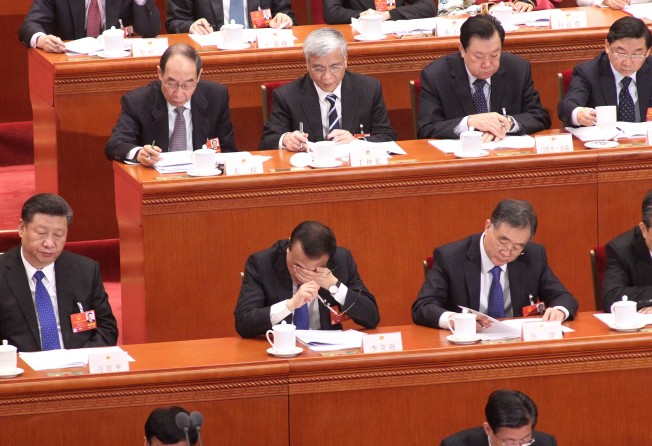Xi shakes up Chinese government to cut bureaucracy, end turf wars
More than two dozen ministries and agencies affected in major overhaul designed to give Communist Party greater control

China unveiled an ambitious plan to revamp its central government structure, with more than two dozen ministries and organisations affected, two days after President Xi Jinping secured the right to stay in power indefinitely.
The sweeping institutional changes are part of Xi’s plan to improve the Communist Party’s governing efficiency by shaking up vested interests among agencies. They include the merger of the banking and insurance regulators, and the setting up of special agencies to oversee issues related to immigration and military veterans.
While the internal power realignment is aimed at strengthening one-party rule, an analyst said the new government line-up in some ways resembled the structure in Washington.
Mao Shoulong, a public administration professor at Renmin University of China, said Beijing had borrowed a few ideas from the United States to improve its government structure.
“So for example, the Ministry of Veterans Affairs follows the US Department of Veterans Affairs, and the planned immigration administration is China’s answer to the US Citizenship and Immigration Services,” Mao said, referring to two of the new agencies.
“It is also a plan aimed at very Chinese problems, such as a lack of communication and turf wars between different government institutions – these are long-standing problems that require strong leadership to solve,” Mao said. “With Xi, the strong leadership is here.”
According to the plan released on Tuesday, the number of ministerial-level government agencies under the State Council, China’s cabinet, will be reduced by eight, while seven vice-ministerial agencies will also be cut, as related functions at different government bodies are pulled together into a single ministry.
The creation of a Ministry of Emergency Management, for example, will centralise the administration of all natural and man-made disasters, from earthquakes to forest fires. Under the current, disjointed system, the nature of the incident defines which government agency deals with it. So forest fires come under the auspices of the forestry administration, but grassland blazes are left to the agriculture ministry.
In another move, China will create a National Market Supervision and Administration Bureau to take on the responsibilities of quality checks, food and drug safety, anti-monopoly investigations and pricing administration – areas that previously fell under various government bodies.
The reshuffle plan, which is expected to be endorsed by the National People’s Congress later this week, marks one of the biggest changes to the central government in the history of the People’s Republic of China. The last reshuffle of a similar scale happened in 1998, when then premier Zhu Rongji closed or merged 15 ministries and commissions under the State Council.
Despite the breadth of the plan, rumoured changes to the Hong Kong and Macau Affairs Office proved to be unfounded, while an anticipated Ministry of Energy also failed to appear.
The power of the influential National Development and Reform Commission – often dubbed the “little State Council” – will be reduced under the new plan.
The vested interests of agencies have long undermined efficiency in Beijing, a problem summed up in the expression, “central government directives won’t travel beyond the walls of Zhongnanhai”, referring to the compound where Chinese leaders live and work.
The Ministry of Environment Protectional, for example, only recently gained teeth as its efforts to clean up the air and water have often come into conflict with other government agencies pursuing industrial development and infrastructure projects.

There are also conflicts of interest. The China Insurance Regulatory Commission, which is to be merged with the banking regulator, has been blamed for creating financial risks by giving some insurers special treatment under disgraced former chairman Xiang Junbo.
The shake-up intends to address these problems. Authority for managing climate change and pollution issues, for example, will be transferred from the economic planning agency to the Ministry of Ecological Environment, while responsibility for administering tobacco controls will move to the National Health Commission from the industry ministry.
Another significant change is the dismantling of the family planning commission. After nearly four decades of the “one-child” policy, which was often brutally implemented with forced abortions and heavy fines for unauthorised births, China will no longer have a formal government institution to manage the issue.
Cheng Enfu, a researcher with the Chinese Academy of Social Sciences and one of the 3,000 NPC delegates who will vote on the plan, said on Tuesday that the new structure showed Beijing’s desire to create a more efficient bureaucracy, akin to those in “developed countries”.
“A developed country generally has about 20 or so ministerial bodies,” Cheng said.
Even with the changes though, he said China had too many government agencies as “there are not only formal ministries but also many other ministerial-type institutions”.